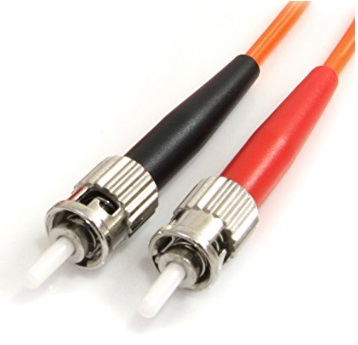Fiber Optic Connectors - The Complete Guide
By Michael Stones
The network cabling industry's fiber optic manufacturers over the last few decades have
been on a constant mission to develop the better fiber connector. This means lower cost, lower
dB losses, easier to terminate out in the field. There have been over 100 connectors developed
over the years but a select few have stood the test of time and beat out their competition.
Below we will talk about the most common.
A fiber optic connector terminates at the end of a fiber optic cable and is used when
you need a means to connect and disconnect the fiber cable quickly. A fiber splice would be
used in a more permanent application. The connectors provide a mechanical connection for the
two fiber cables and align both cores precisely so the light can pass through with little loss.
There are many different types of connectors but many share similar characteristics. Many connectors
are spring loaded. This will push the fiber ends very close to each other so as to eliminate
airspace between them, which would result in higher dB losses.
Components of a Fiber Optic Connector
There are generally five main components to a fiber connector: the ferrule, the body,
the coupling structure, the boot and the dust cap.
Ferrule -the ferrule is the small round cylinder that actually makes contact with the
glass and holds it in place. These are commonly made of ceramic today but also are made of
metal and plastic.
Body -This sub assembly holds the ferrule in place. It then fits into the connector housing.
Housing -This holds all sub assembly parts in place and has the coupling that
will connect to the customer's equipment. The securing mechanism is usually bayonet, snap-in
or a screw on type.
Boot -This will cover the transition from the connector to the fiber optic cable. Provides
stress relief.
Dust Cap -Just as it implies will protect the connector from accumulating dust.
Types of Fiber Optic Connectors
There are many types of connectors on the market. The major differences are the dimensions
and the method of connection to equipment. Most companies will settle on one type of connector
and keep that as a standard across the board. It makes sense because all equipment has to be
ordered with that specific connector type and to have 2 or 3 different connector types can
get messy. For typical network cabling projects today LC is fast becoming the shining star
of fiber connectors. LC is a small form factor connector which means it requires a much smaller
footprint in your IT closet. Thus you can fit many more LC connectors into you fiber panels
then say ST or SC connectors.
ST Connector

The ST connector (or Straight Tip) was the first popular connector type to be used as
a standard for many organizations in their fiber network applications. It was first developed
by AT&T. Often called the "round connector" it has a spring loaded twist bayonet mount with
a 2.5mm round ferrule and a round body. The ST connector is fast being replaced with the smaller,
denser SFF connectors.
| 
